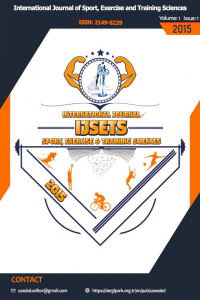The relation of physical activity to physical and mental health level in adolescents
The relation of physical activity to physical and mental health level in adolescents
Physical activity Physical and mental health, Students,
___
- American College of Sports Medicine (2013). ACSM’s guidelines for exercise testing and prescription, 9th ed. Williams & Wilkins, Baltimore.
- Brown, D.W., Balluz L.S., Heath, G.W., Moriarty, D.G., Ford, E.S., Giles, W.H., Mokdad, A.H. (2003). Associations between recommended levels of physical activity and health-related quality of life. Findings from the 2001 Behavioral Risk Factor Surveillance System (BRFSS) survey. Prev Med. 37:520–528.
- Cengiz, C., Aşçi, F.H. & İnce, M.L. (2010). Exercise stages of change questionnaire: its reliability and validity. Türkiye Klinikleri Journal of Sports Sciences. 2(1): 32-37.
- Çeker, A., Çekin, R., Ziyagil, M.A. (2013). Regular Physical Activity Stages of Behavior Change in Women and Men from Different Age Groups. [Farklı yaş gruplarındaki kadın ve erkeklerin düzenli fiziksel aktiviteye katılım davranışı değişim basamakları.] CBÜ Beden Eğitimi ve Spor Bilimleri Dergisi: 8(1): 11-20.
- Çetinkaya, G. & Ömüriş E. (2017). Examination of outdoor sports activities on ındividuals’ positive and negative affect. Int J Sport, Exer & Train Sci, Vol 3, Issue 3, 76–85.
- Demiral, Y. Ergor, G., Unal, B., Semin, S., Akvardar, Y., Kıvırcık, B., & Alptekin, K. (2006). Normative data and discriminative properties of short form 36 (SF-36) in Turkish urban population. BMC Public Health, 6:247.
- Douglas, K. A., Collins, J. L., & Warren, C. (1997). Results from the 1995 National College Health Risk Behavior Survey. Journal of American College Health, 45, 55-66.
- Danylchuk, K. (2007). “Leisure Sport and Sport Entertainment in the University”. Universiade Bangkok 2007 FISU Conference, 9-12 August 2007 s.49-58.
- Fontaine, K.R. & Barofsky, I. (2001). Obesity and health-related quality of life. Obes Rev. 2:173–182. Genc, A., Sener, Ü., Karabacak, H. & Uçok, K. (2011). Investigation of physical activity and quality of life differences between male and female young adults. The Medical Journal of Kocatepe. 12: 145-150.
- Giannakopoulos, G., Dimitrakaki, C. Pedeli, X., Kolaitis, G. Rotsika, V. Ravens-Sieberer, U., & Tountas, Y. (2009). Adolescents' wellbeing and functioning: relationships with parents' subjective general physical and mental health. Health and Quality of Life Outcomes. 9, 7:100
- Gorczynski, P. & Faulkner, G. (2010). Exercise therapy for schizophrenia. Schizophr Bull. 36(4):665–666.
- Hunter Institute of Mental Health (2015). Prevention First: A Prevention and Promotion Framework for Mental Health. Newcastle: Hunter Institute of Mental Health.
- Morgan, V.A., Waterreus, A., Jablensky, A., Mackinnon, A., McGrath, J.J., Carr, V., Bush, R., Castle, D., Cohen, M., Harvey, C., Galletly, C., Stain, H.J., Neil, A.L., McGorry, P., Hocking, B., Shah, S, Saw, S. (2012). People living with psychotic illness in 2010: The second Australian national survey of psychosis. Australian and New Zealand Journal of Psychiatry. 46(8):735-752.
- Pan Korur, A. (2010). Assessment of health care utilization in different sociocultural groups living in the Adana City Center. Unpublished Doctoral Dissertation, Department of Family Medicine, Faculty of Medicine, Çukurova University.
- Sevimli, D., Kozanoglu, E., Guzel, R., & Doganay, A. (2015). The effects of aquatic, isometric strength-stretching and aerobic exercise on physical and psychological parameters of female patients with fibromyalgia syndrome J. Phys. Ther. Sci. 27: 1781–1786.
- Shah, D., Anupindi, V.R., Vaidya, V., & Holiday-Goodman, M. (2015). Factors affecting health-related quality of life in individuals with depression. Presented at the ISPOR 20th Annual International Meeting May 16-20, 2015, Philadelphia, PA.
- Tavazar, H., Erkaya, E., Yavaş, Ö., Tez, Ö., Zerengök, D., Güzel, P. & Özbey, S. (2014). The research of the differences between physical activity and life quality in senior high school students (Manisa City example) Special Issue on the Proceedings of the 3rd ISCS Conference, SI (1): 496-510.
- US Department of Health and Human Services (2008). Physical activity guidelines for Americans.
- Ware, J.E., Kosinsky, M., & Keller, S.D. (1995). SF12: How to Score the SF12 Physical and Health Summary Scales, 2nd Ed. Boston, MA: The Health Institute, New England Medical Center,
- Ware, J.E., Kosinski, M, Turner-Bowker, D.M., Gandek, B. (2008). User’s Manual for the SF-12v2 Health Survey (with a supplement documenting SF-12 health survey). Lincoln, RI: Quality Metric Incorporated.
- WHO (2008). The global burden of disease: 2004 update, World Health Organization, Geneva.
- WHO (2010). Global recommendations on physical activity for health. World Health Organization, Report of a WHO forum and technical meeting, Geneva, 15-17.
- ISSN: 2149-8229
- Başlangıç: 2015
- Yayıncı: İbrahim ERDEMİR
Nazmi BAYKÖSE, Selma CİVAR YAVUZ, Pakize KESKİN, Mustafa KILINÇ
9-14 yaş badmintoncularda çeviklik, reaksiyon zamanı ve denge parametrelerinin incelenmesi
Seydi Ahmet AĞAOĞLU, Rıdvan ERGİN
Sınıf öğretmeni adaylarının beden eğitimi dersine yönelik tutumları
Gönül TEKKURŞUN DEMİR, Halil İbrahim CİCİOĞLU, Ekrem Levent İLHAN, Özlem ARSLAN
The Evaluation of balance performance for elite male karate athletes after fatigue
Meryem GÜLER, İrfan GÜLMEZ, Semih YILMAZ, Nusret RAMAZANOĞLU
Algılanan yönetici desteğinin örgütsel bağlılığa etkisi: Profesyonel futbolcular örneği
İlhan ADİLOĞULLARI, Recep GÖRGÜLÜ, Hakkı ULUCAN
Nurlan HASANLI, Sami ALTUNTAŞ, Mehmet Zeki SARI, Yaşar Gül ÖZKAYA
Tuba KIZILET BOZDOĞAN, Ali KIZILET
Capoeira’nın sosyalleşmeye etkisinin bazı değişkenler açısından incelenmesi
Serkan HACICAFEROĞLU, Burhanettin HACICAFEROĞLU, Recep Fatih KAYHAN, Güngör DOĞANAY
The relation of physical activity to physical and mental health level in adolescents
Ömer Faruk İNEÇLİ, Mehmet Akif ZİYAGİL
Üniversite öğrencilerinde internet bağımlılığı ile kişilik ilişkisinin incelenmesi
